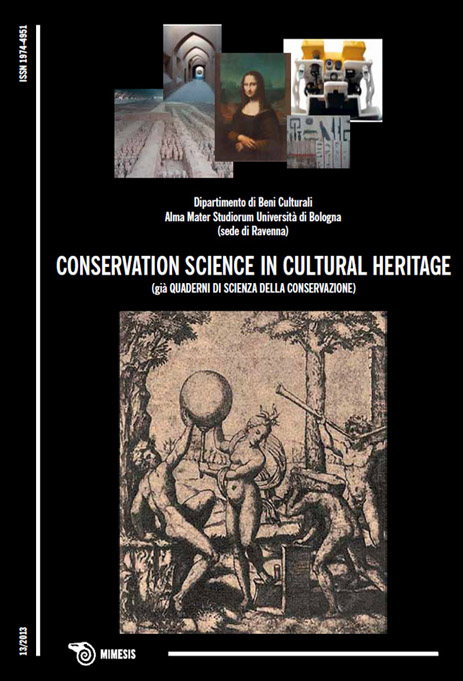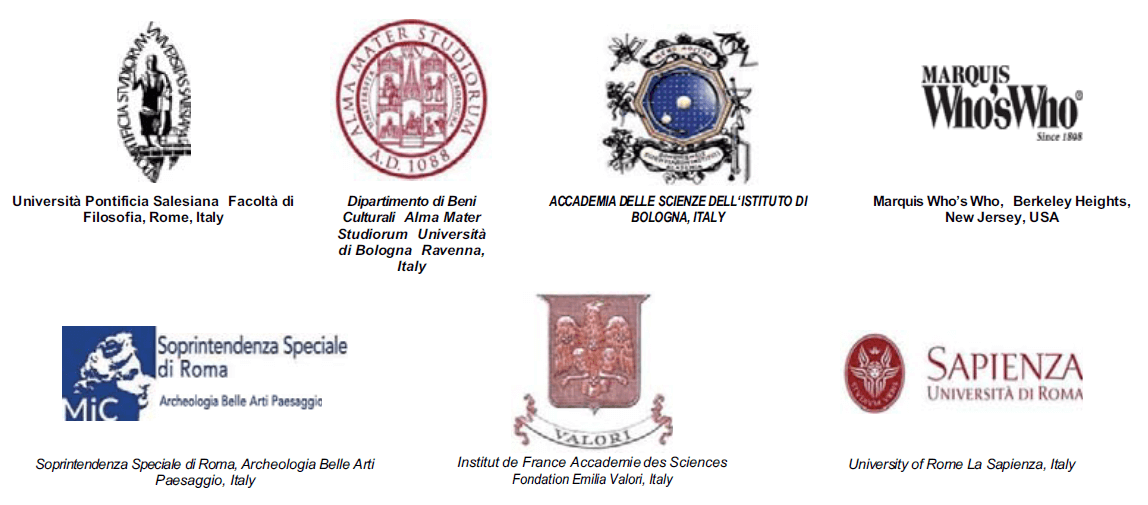Diagnostic-analytical study of the painting “Gioconda with columns”
DOI:
https://doi.org/10.6092/issn.1973-9494/4178Keywords:
“Gioconda”, “Gioconda with columns”, Leonardo, authenticationAbstract
Summary
The painting “Gioconda with columns” from a private collection re-proposes a work of art that is “unique” in the art world, in other words, the “Mona Lisa” by Leonardo da Vinci. The presence of the columns represents the most significant distinguishing feature when compared to the “Mona Lisa” housed in the Louvre.
Consequently the question arises: “Is the painting “Gioconda with columns” attributable to the genius of Leonardo or one of his followers or is it to be considered a copy of the “Mona Lisa” in the Louvre or the second “Gioconda” or a copy of the latter?”
Thus, the investigation is directed towards identifying the constituent materials and characterizing the pictorial technique in order to artistically collocate its execution and contribute to providing a reliable answer based on both a subjective and objective evaluation.
For this purpose, the study was conducted with the cooperation of an art historian and restorer, as well as a physicist and a technical diagnostician, thus integrating competences that were able to lead to the final results.
Riassunto
Il dipinto “Gioconda con colonne” di collezione privata ripropone un’opera d’arte “unicum” nel mondo dell’arte, ovvero “Monna Lisa-Gioconda” di Leonardo da Vinci. La presenza delle colonne rappresenta l’aspetto distintivo più significativo rispetto a “La Gioconda” conservata al Louvre.
Sorge di conseguenza la domanda: «Il dipinto “Gioconda con colonne” è da ricondurre al genio Leonardesco o ad un suo seguace, o è da considerare una copia de “La Gioconda” conservata al Louvre o la seconda “Gioconda” o una copia di quest’ultima?»
L’indagine è quindi rivolta all’identificazione dei materiali costituenti e alla caratterizzazione della tecnica pittorica con lo scopo di collocare artisticamente l’esecuzione e contribuire a fornire una risposta affidabile sulla base di una valutazione sia soggettiva che oggettiva.
A tal riguardo lo studio è stato condotto con il concorso dello storico dell’arte, del restauratore oltre che fisico e del tecnico-diagnosta, in una integrazione di competenze che hanno potuto condurre ad una risultanza finale.
Résumé
Le tableau « Joconde aux colonnes », provenant d’une collection privée, propose encore une fois une œuvre qui est un « unicum » dans le monde de l’art, à savoir « Mona Lisa/Joconde » de Léonard de Vinci. La présence des colonnes est l’aspect le plus significatif qui le distingue de « La Joconde » conservée au Louvre.
La question qui se pose est alors la suivante : « Le tableau “La Jocondeaux colonnes” est-il dû au génie de Léonard ou à celui de l’un de ses disciples, ou doit-on le considérer comme une copie de “La Joconde” conservée au Louvre, ou comme la deuxième “Joconde”, ou comme une copie de cette dernière ? »
L’investigation est donc axée sur l’identification des matériaux utilisés et sur la caractérisation de la technique picturale, afin de situer l’exécution au niveau artistique et de contribuer à fournir une réponse fiable, d’après une évaluation tant subjective qu’objective.
Dans ce cadre, l’étude a été conduite avec le concours de l’historien de l’art, du restaurateur, du physicien et du technicien diagnostiqueur, dans une intégration des compétences qui a pu conduire à des conclusions finales.
Zusammenfassung
Das aus einer Privatsammlung stammende Gemälde “Gioconda con colonne” (etwa: Mona Lisa mit Säulen) erinnert an ein Kunstwerk, das in der Welt der Kunst ein „Unikum“ darstellt, das heißt die “Mona Lisa“ von Leonardo da Vinci. Das Vorhandensein der Säulen bildet das bedeutsamste Unterscheidungsmerkmal gegenüber der im Louvre verwahrten „Mona Lisa“.
Daraus ergibt sich die Frage: «Ist das Gemälde “Gioconda con colonne” dem Genie Leonardos oder einem seiner Schüler zuzuschreiben, oder ist es als Kopie der im Louvre verwahrten „Mona Lisa“, als zweite „Mona Lisa“ oder als Kopie dieser letzteren zu betrachten?»
Die Untersuchung gründet sich hier auf die Identifizierung der verwendeten Materialien und der Maltechnik, um die Ausführung künstlerisch einstufen und eine zuverlässige Antwort auf der Grundlage sowohl einer subjektiven als auch einer objektiven Beurteilung geben zu können.
Diesbezüglich wurde die Studie mit Unterstützung von Kunsthistorikern, Restaurateuren sowie Physikern und technischen Diagnostikern betrieben, wodurch die Integration von Fachkompetenzen zustande kam, die schließlich zu einem Endergebnis geführt hat.
Resumen
La pintura "Gioconda con columnas" de una colección privada vuelve a proponer una obra de arte única en el mundo del arte, es decir "Mona Lisa-Gioconda" de Leonardo da Vinci. La presencia de las columnas representa la característica distintiva más significativa respecto a "La Gioconda" conservada en el Louvre.
Como consecuencia surge una pregunta: «¿La pintura "Gioconda con columnas" ha de ser reconducida al genio de Leonardo o a uno de sus secuaces, o ha de ser considerada una copia de "La Gioconda" conservada en el Louvre, la segunda "Gioconda" o una copia de la última?».
Por tanto, la investigación está orientada a identificar los materiales constitutivos y a delinear el carácter de la técnica pictórica con el objetivo de colocar artísticamente su ejecución y dar una contribución para brindar una respuesta fiable basada en una valoración tanto subjetiva como objetiva.
Por ello el estudio ha sido realizado con la colaboración de un historiador de arte, de un restaurador, además de un físico y de un técnico-diagnóstico, quienes han reunido las competencias que han permitido llevar a un resultado final.
Резюме
Картина «Джоконда с колоннами» из частной коллекции повторяет уникальное произведение исскуства, то есть «Мона Лизу – Джоконду» Леонардо да Винчи. Присутствие колонн является наиболее значительным элементом, отличающим ее от «Джоконды», находящейся в Лувре. Возникает как следствие этого вопрос: присваивать ли картину «Джоконда с колоннами» гениальности Леонардо или его приемнику или считать ее копией «Джоконды», хранящейся в Лувре, или это вторая «Джоконда» Леонардо или копия второй «Джоконды»?
Исследование, следовательно, обращено на идентификацию составляющих материалов и характеристику техники живописи с целью художественного размещения исполнения и для обеспечения надежного ответа на основе субъективной и объективной оценки.
В связи с этим, исследование было проведено при содействии историка искусства, реставратора, а также физика и техника-диагноста, при интеграции компетенций, которые смогли привести к окончательному результату.
摘要
“Gioconda con colonne(带圆柱的蒙娜丽莎)”这幅私人珍藏画再次呈现了艺术世界独一无二的珍品,即列奥纳多达芬奇的“蒙娜丽莎”。画里的圆柱代表与卢浮宫“蒙娜丽莎”最明显的区分因素。因此出现了这个问题: «“Gioconda con colonne(带圆柱的蒙娜丽莎)”这幅画是由天才达芬奇或他的追随者画的,或者是卢浮宫“蒙娜丽莎”的模仿画,又或者是第二个“蒙娜丽莎”还是第二个“蒙娜丽莎”的模仿画?»
这种研究针对画家使用的材料和画画技巧的特征而确定作画者的风格,通过一种主观和客观的分析提供了一个可靠的答案。
其实上述研究是在艺术史学家、文物修复学家、物理学家和技术诊断学家的协助下进行的,在他们的共同合作下得到了最终结果。
References
CONTI A., 1988, Storia del restauro e della conservazione delle opere d’arte, Milano
PIVA G., 2007, L’Arte del Restauro. Il restauro nei dipinti nel sistema antico e moderno, Hoepli, Milano.
FIORI, C., LORUSSO S., PENTRELLA L., 2003, Restauro, manutenzione, conservazione dei beni culturali: materiali, prodotti e tecnologie, Pitagora Editrice, Bologna
BALDINI U., DAL POGGETTO P., 1972, Firenze restaurata, Firenze
LORUSSO S., GALLOTTI L., 2007, Caratterizzazione, tecnologia e conservazione dei manufatti tessili, Pitagora Editrice, Bologna
LORUSSO S., SCHIPPA B., 2001, Le metodologie scientifiche per lo studio dei beni culturali, Pitagora Editrice, Bologna
VILLERS C., 1995, Painting on canvas in fourteenth century Italy, Zeitschrift fur kunstgeschighte, 58, III, pp. 338-358
VILLERS C., 1981, Artists’ canvases, Proceedings of the ICOM committee for conservation, vol. 2, pp. 1-12. Ottawa
CENNINI C., 1971, Il libro d’arte, a cura di Brunello F., Vicenza
ARMENINI G. B., 1979, De’ veri precetti della pittura, Scritti d’arte del cinquecento, Torino
PERIERD’IETEREN C., 1985, Colyn de Coter. Technique picturale des peintres flamands du XVe au debut du XVIesiecle. Bruxelles, Lefebvre &Gillet
SECCARONI C., MOIOLI P., 2002, Fluorescenza X. Prontuario per l’analisi XRF portatile applicata a superfici policrome, Nardini Editore, Firenze
ROY A., 1999, Painting in Antwerp and London. The National Gallery Van Dycks: Technique and development, National Gallery Technical Bulletin, vol. 20
VOLPATO G. B., 1967, Modo de tener nel dipingere, Original treatises, dating from the XIIIth to XVIIIth cent. on the art painting, vol. II. New York
DUNKERTON J., ROY A., 1998, Uccello’s ‘Saint George and the dragon’ : technical evidence revaluated, National Gallery Technical Bulletin, vol. 19
RINALDI S., QUARTULLO G., et al., 1995, La fabbrica dei colori. Pigmenti e coloranti nella pittura e nella tintoria, Bagatto libri, Roma
LORUSSO S., 2002, La diagnostica per il controllo del sistema manufatto-ambiente, Pitagora Editrice, Bologna
RUDEL J., 1962, Le probléme du support dans l’historie de la peinture, L’information de l’historie de l’art, 7
VASARI G., 1962-1966, Le vite, a cura di Della Pergola P., Grassi L., Previtali G., Milano
LORUSSO S., NATALI A., MATTEUCCI C., 2007, Colorimetry Applied to the Field of Cultural Heritage: Examples of Study Cases, Conservation Science in
Cultural Heritage, 7, pp. 187-220
LAZZARINI L., 1983, Il colore nei pittori veneziani tra il 1480 e il 1580, Studi veneziani. Ricerche d’archivio e di laboratorio ‘Bollettino d’Arte’, Roma
MARTIN G., 1970, Flemish school, 1600-1900, National Gallery Catalogues, London
DE MAYERNE T.T., 1995, Pittura scultura e delle arti minori. 1620-1646, a cura di Simona Rinaldi, De Rubeis, Anzio
HENDRIKS E., GROEN K., 1994, Double grounds of this type for [1] portraits on canvas continued in use in England until at least the late 1640s, Hamilton Kerr
Institute Bulletin, 2
PAPA R., 2011, Leonardo. La tecnica pittorica, Art e Dossier n. 281, Giunti, Milano
PEDRETTI C., 2005, Leonardo. La pittura, Art e Dossier n. 215, Giunti, Milano
PLESTERS J., 1968, Photomicrographs of cross-sections of paint and ground samples, Museum, XXI, n. 4
PLESTERS J., 1980, Tintoretto’s paintings in the National Gallery, National Gallery Technical Bulletin, n.4
FAILLANT DUMAS L., 1980, Restauration des peintures, Catalogo a cura di Bergeon S., Paris
WOLFTHAL D., 1989, The beginnings of nederlandish canvas paintings: 1400-1530, Cambridge, 1989
MARANI P. C., 2000, Leonardo da Vinci. The complete paintings, Harry N. Abrams, New York
PEDRETTI C., LAURENZA D., SALVI P., 2005, Leonardo. L’anatomia, Art e Dossier n. 207, Milano
LARRY K., ROY A., MORRISON R., SCHADE P., 2011, Leonardo da Vinci’s Virgin of the Rocks: Treatment, Technique and Display, National Gallery Technical Bulletin, n.32
DUNKERTON J., 2011, Leonardo in Verrocchio’s workshop: Re-examining the tecnical evidence, National Gallery Technical Bulletin, n. 32, London
PEDRETTI C., 1992, Leonardo. Il disegno, Art e Dossier n. 67, Giunti, Milano
MOHEN J.-P., (a cura di), 2005, Aucoeur de La Joconde. Léonard de Vinci décodé, Centre de Recherche et de Restauration des Musées de France, Gallimard, Musée du Louvre éditions
HENDY P., LUCAS A. S., 1968, The ground in picture, Museum, XXI, 4
ZÖLLNER F., 2007, Leonardo da Vinci. Tutti i dipinti e i disegni, Taschen, Köln
SLATKES L. J., 1965, Dirck van Baburen. A Dutch painter in Utrecht and Rome, Utrecht
COREMANS P., THISSEN J., 1961, Het calvarie, drieluiktoegeschreven van Justus van Gent en de bijbehorendepredella. Samenstelling en structuur van der verflaag, Bulletin, IRPA, IV
PLAHTER L. E., PLAHTER U. S., 1983, The Young Christ among the Doctors by Teodoer van Baburen, Actaadarchaeologiam et artiumhistoriampertinentia, III
Downloads
Published
How to Cite
Issue
Section
License
Copyright (c) 2013 Salvatore Lorusso, Chiara Matteucci, Andrea Natali, Salvatore Andrea Apicella, Flavia Fiorillo
Copyrights and publishing rights of all the texts on this journal belong to the respective authors without restrictions. Authors grant the journal right of first publication.
This journal is licensed under a Creative Commons Attribution 4.0 International License (full legal code).
See also our Open Access Policy.






